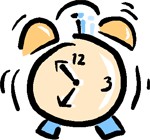Bellringers for Biology
| HOME | Biology | Anatomy | Yearbook | Links |
 |
|
| Bellringer #28
1. In the video, the turtles had different types of shells. Why do you think this is true? 2. Why do the finches have different beaks? 3. Explain how the marine iguana is unique. |
|
| Bellringer #27
1. Where does transcription take place and why? 2. Why do you think this process is called transcription? 3. Where does translation take place, and why do you think it is called “translation?” |
|
| Bellringer #26
1. Briefly describe the steps involved in gene expression. 2. Write the DNA strand that codes for the following mRNA strand. UCUAGAGGCAGGCCA 3. Define the following mutations: substitution- deletion- insertion- |
|
| Bellringer #25
1. Name the start codon on the mRNA strand, and tell what amino acid it codes for. 2. Name the stop codons. 3. Briefly describe steps 2-5 in translation. |
|
| Bellringer #24
1. What does a repressor protein do? 2. Describe how it works. 3. Briefly describe steps 2-5 in translation. |
|
| Bellringer #23
1. Name the start codon on the mRNA strand, and tell what amino acid it codes for. 2. Name the stop codons. 3. Briefly describe steps 1-7 in translation. |
|
| Bellringer #22
1. What is uracil? 2. What is gene expression? 3. Describe the 3 steps of transcription. |
|
| Bellringer #21
1. Draw a diagram of the DNA molecule. 2. What are the basic subunits of a nucleic acid like DNA? 3. List the way the nitrogenous bases pair up in DNA (adenine, cytosine, guanine, thymine) 4. What is the function of DNA? |
|
| Bellringer #20
Define the following terms: 1. Monohybrid cross 2. Dihybrid cross 3. Dominant allele 4. Recessive allele 5. Codominance 6. Incomplete dominance 7. Sex-linked disorder |
|
| Bellringer #19
1. Using a Punnett square determine the offspring of a cross between a parent heterozygous for purple flowers (Pp) and a parent homozygous for white flowers(pp). List genotype and phenotype. 2. Using a Punnett square, determine the offspring from a cross with one parent homozygous for purple flowers and heterozygous for tall (PP Tt), and the other parent homozygous for white flowers, and heterozygous for dwarf (pp Tt). List genotype and phenotype. |
|
| Bellringer #18 In your notebooks write, “Bellringer #18 – see Chapter 8 Notes” Fill in the “K” column of your Chapter 8 Notes. |
|
| Bellringer #17
Occasionally homologous chromosomes fail to separate during meiosis I. Using the hypothetical example of an adult organism that has two pairs of chromosomes, describe the chromosomal makeup of the egg that would result from this error. Also include a sketch to help explain your answer. |
|
| Bellringer #16
1. Name the stage of meiosis during which chromatids are separated to opposite poles of the cell. 2. Explain whether the statements below are true or false: a. Mitosis and meiosis both result in diploid cells b. If a cell begins with two pairs of homologous chromosomes, each cell that is produced at the end of meiosis I will have 2 chromosomes. |
|
| Bellringer #15
Name the stage of Meiosis when the following conditions occur. 1. Crossing-over 2. Separation of homologous chromosomes 3. Matching up of homologous structures 4. Separation of chromatids to opposite poles |
|
| Bellringer #14
1. If one cell in a dog (2n = 78) undergoes meiosis and another cell undergoes mitosis, how many chromosomes will each resulting cell contain? 2. Using the table on the left, explain the relationship between number of chromosomes and complexity of the organism. |
|
| Bellringer #13 Define the following terms: 1. Karyotype 2. Disjunction 3. Nondisjunction 4. Trisomy 5. Mutation 6. Inversion 7. Deletion 8. Translocation 9. Duplication |
|
| Bellringer #12
1. Explain the significant events that occur at each stage of mitosis. 2. What are you left with at the end of mitosis? 3. Explain the difference between the following terms: a. Gametes, zygote b. Mitosis, meiosis |
|
| Bellringer #11
1. Name the four bases that make up DNA. 2. What is mitosis? |
|
| Bellringer #10
1. Describe and sketch the structure of DNA. |
|
| Bellringer #9
1. How do prokaryote and eukaryote cell reproduction differ? 2. Explain the difference between gene, chromosome, and DNA. 3. Explain the difference between chromosome and chromatid. |
|
| Bellringer #8
Copy the following statement and write down and explain why you agree or disagree with the statement. 1. Chromosomes from females determines the gender of humans 2. Every human cell contains 46 chromosomes. 3. Healthy cells cannot become cancerous cells. |
|
| Bellringer #7
1. Explain how the following environments conditions would impact the rate of photosynthesis: a. Temperature (colder or warmer) b. Amount of CO2 c. Amount of sunlight 2. Explain the difference between light and dark reactions in photosynthesis. |
|
| Bellringer #6
1. List the steps of photosynthesis, describing the needed reactants and end products for each. 2. List the steps of cell respiration, describing the needed reactants and end products for each. |
|
| Bellringer #5
1. Explain the difference between aerobic and anaerobic. 2. What is glycolysis? 3. What happens to the 6-carbon molecule of glucose during glycolysis? |
|
| Bellringer #4
1. What color was the bromothymol blue before you exhaled into it? 2. After you blew into it? 3. Why did we use bromothymol blue in this experiment? |
|
| Bellringer #3
1. Sketch the flow chart that was on the website outlining the steps of photosynthesis. 2. How do plants absorb CO2 ? 3. Why do plants release O2 ? |
|
| Bellringer #2
1. Describe what occurs in Stage One of the photosynthesis. 2. Write out the photosynthesis summary reaction. |
|
| Bellringer #1 |
|